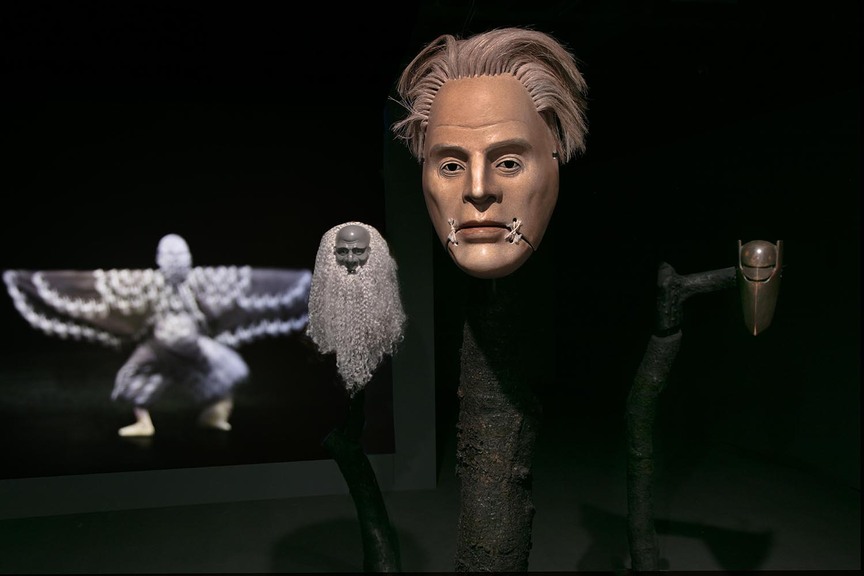-
From Current Issue
-
- Editor’s Letter Fire in the Heart
- Reviews I Gusti Ayu Kadek Murniasih
- Reviews 11th Seoul Mediacity Biennale: “One Escape at a Time”
- Dispatch Networked China
- One on One Monira Al Qadiri on Yukio Mishima
- Essays The rise of independent art spaces in pandemic-era Shanghai
- Features Tuan Andrew Nguyen
- Table of Contents
- Web Exclusives
- Archive
- Subscribe

R
E
V N
E
X
T
To enter the exhibition “At Twilight” at New York’s Japan Society Gallery is to travel through time with British-born artist Simon Starling. His works take viewers into the depths of Ashdown Forest in England where WB Yeats and Ezra Pound sheltered during World War I spending hours contemplating Noh, Japan’s traditional masked theater. Starling has long been fixated on Yeats’ Noh-inspired play At the Hawk’s Well (1916), which emerged from the time spent with Pound. Through this exhibition, Starling reimagines not just the production of At the Hawk’s Well—an enchanting orientalist drama staged in a London salon in 1916—but also resurrects a tumultuous moment in history.
Upon entering the first gallery, visitors are immersed into a dark space and hit by a haunting score of music. A strange forest of masks perched on barren trees surrounds the viewer, and in the distance, a figure dressed as a hawk performs a primordial dance on a video screen. Doing away with formal boundaries between audience and actors, Starling thrusts viewers directly onto a recreated stage for At the Hawk’s Well, which he produced in Glasgow earlier this year (July to September). The forest evokes the bombed landscapes of World War I while the masks represent personalities associated with the original play ranging from Nancy Cunard, the heiress whose home was the venue for the drama’s 1916 debut, to Michio Itō, a Japanese émigré dancer who performed in the original production.
Starling traveled to Osaka to meet Yasuo Michii, a traditional Noh mask maker who he worked with to create the props. While Michii fashioned Cunard’s elongated gold mask using Japanese traditional techniques and materials including charred oak and lacquer, the face was modelled after Constantin Brancusi’s minimalist portrait of the heiress. There is a similar intermingling of East and West in the other masks as Starling uses them to evoke the complexities of the cross-cultural play. Similarly, in the next room sits a series of costumes from the Glasgow production including the elaborate winged hawk outfit. Made by Japanese costume designer Kumi Sakurai, it was modelled after a black-and-white photograph of Ito’s costume for Yeats’ original play.
Like Yeats, Starling was unfamiliar with Japanese traditions until this project. Yet in contrast to the Irish poet, there is no trace of orientalism in this show. Starling is acutely aware of the exotic appeal of Noh theatre in the 20th century and how the Asian art form impacted the Western avant-garde. His collaboration with Japanese artists not only conjures Yeats’ play in vivid detail but it also highlights the unusual mutation of the Japanese art form. The interpretation or even misinterpretation of Noh theatre is one aspect of Starling’s larger objective to explore the backstories or “exaggerated detours” linked to Yeats’ project.
The stories orbiting the play multiply as one moves deeper within the show. Another gallery is jam-packed with historic artwork and ephemera linked to the play. Be it tenuous (random Noh masks that Starling selected) or more pertinent (exquisitely scripted correspondence between Yeats and Edmund Dulac, the play’s costume and set designer), the objects provide a resonant backdrop for Starling’s work At Twilight: Mind Map (2014–16). The large annotated collage is an explosion of the ideas percolating in Starling’s mind. One gets a sense of how Starling was inspired by images of executed heads resting on tree branches in Francisco Goya’s Disasters of War (1810–20), pine trees in Noh theatre backdrops and the wasteland of burned trees during World War I, all of which are pictured in the collage. The work also reveals the fascinating tangents he traveled down while creating the exhibition such as contemplating the role of the tree in Samuel Beckett’s play Waiting for Godot (1953). He included an image from a staging of the play showing characters Vladimir and Estragon crouched beside a scraggly tree as well as an intricate illustration of a tree from Irish mythology.
Yet by the time you reach the final work, a documentary on Starling’s Glasgow production, you need space to breathe. At this point it’s hard to absorb any more. The final work feels slightly superfluous as Starling himself says on screen: “Knowing too much can stifle creativity.” His success in this exhibition lies in leaving questions unanswered. Throughout the show it is as if Starling is reweaving a spider web using gossamer threads to reconstruct a story. It is only by leaving strands loose, that he creates space for viewers to piece together the past themselves, leaving them free to imagine their own version of an avant-garde moment that has long been mythologized in history.
“Simon Starling: At Twilight (After W. B. Yeats’ Noh Reincarnation)” is currently on view at Japan Society Gallery, New York, until January 15, 2017.
To read more of ArtAsiaPacific’s articles, visit our Digital Library.







